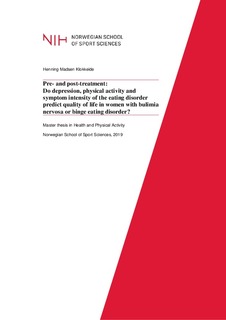| dc.description.abstract | Background: Eating disorders (EDs) are among the top ten of the gender and age adjusted global burden of diseases in terms of poor quality of life, affecting young women in particular. Treatment of EDs generally focus on alleviating ED-symptomology and quality of life (QoL) is usually not considered an outcome measure, although women with EDs claim that well-being and learning to cope with the disease may be just as important as remission from the symptoms of disease. Therefore, an increased understanding of the relationship between EDs and QoL could be beneficial for improving treatment outcomes in this population.
Objective: This study explored the influence of depression, level of physical activity and symptom intensity of eating disorders on quality of life in women with bulimia nervosa (BN) and binge eating disorder (BED) receiving either physical exercise and dietary therapy (PED-t) or cognitive behavioral therapy (CBT).
Method: This study utilized data material obtained at the “PED-t trial”. Of the 149 who met at pre-therapy measures, 148 were included in the current thesis and 111 completed measures at post-therapy. Multiple regression analysis was conducted to estimate the influence of the explanatory power of the regression model and the unique contribution from depression, level of physical activity and symptom intensity of eating disorders on variance in QoL both on the complete sample and the two treatment groups. Pearson correlations was used to identify and describe changes in association between depression and symptom intensity of EDs from pre- to post therapy.
Results: The regression model consisted of depression, physical activity and symptom intensity of eating disorders, explaining 38 % - 60 % of the variance in QoL. Depression and level of physical activity made a significant unique contribution to variance of QoL, accounting for respectively 38 % - 42 % and 4.7 % of the unique variance in QoL in various analysis. The association between symptom intensity of eating disorder and depression changed from weak to moderate from pre- to post-therapy.
Conclusion: Depression may be a more important explanatory variable for QoL than level of physical activity and symptom intensity of eating disorders. It can be beneficial to assess and address depression when treating EDs. | nb_NO |
